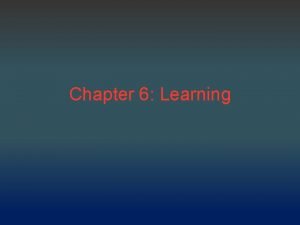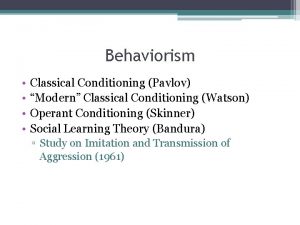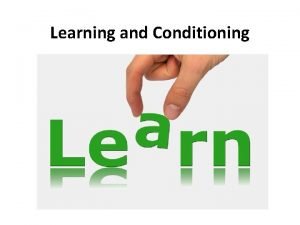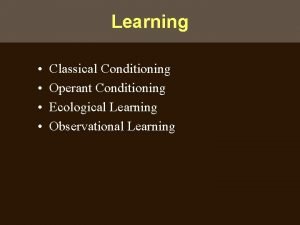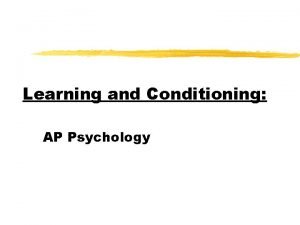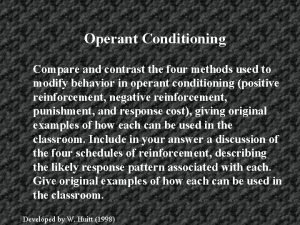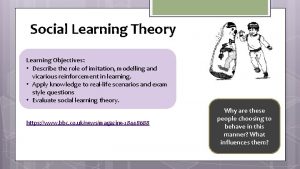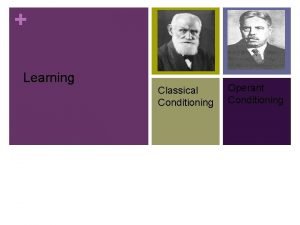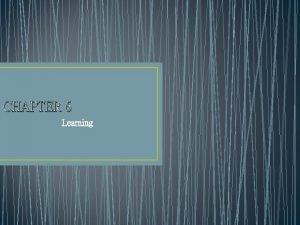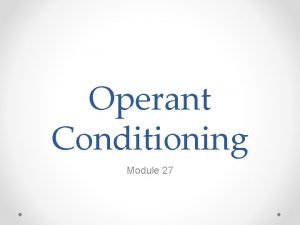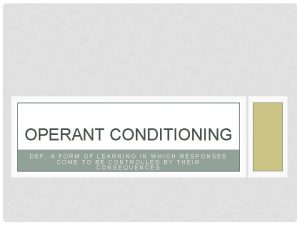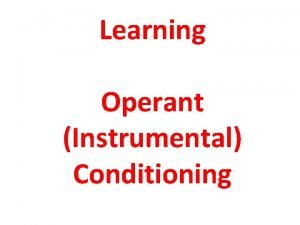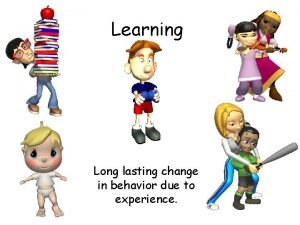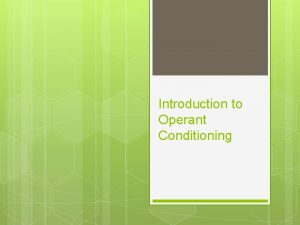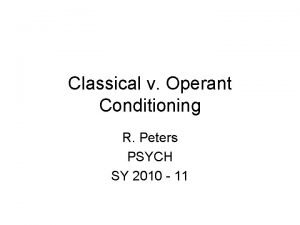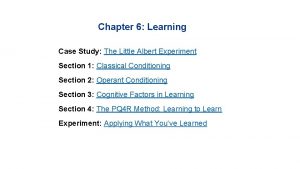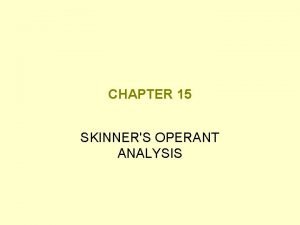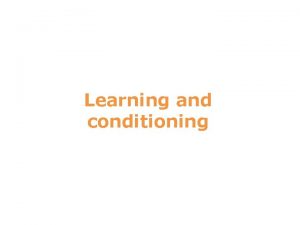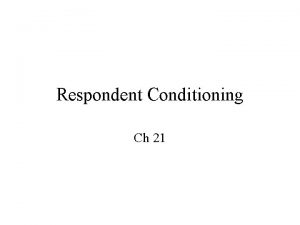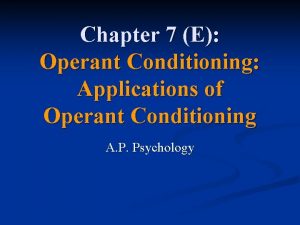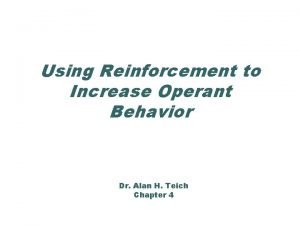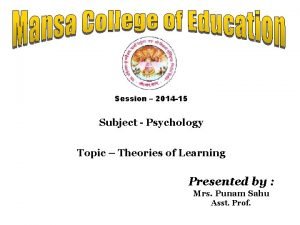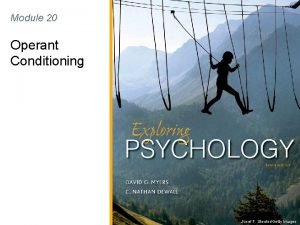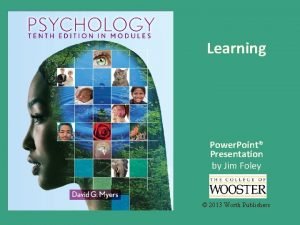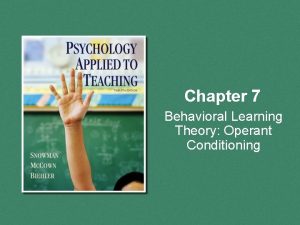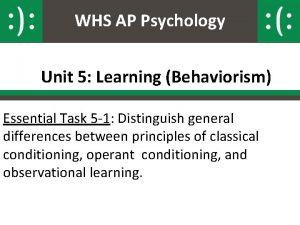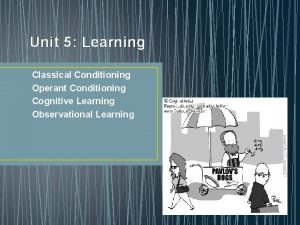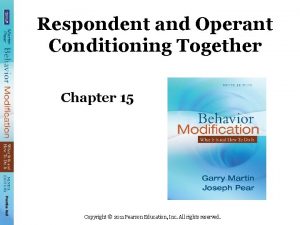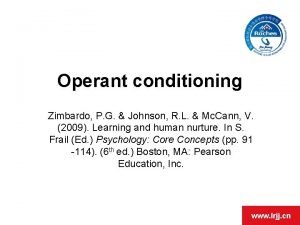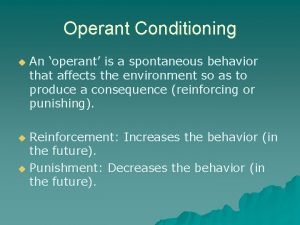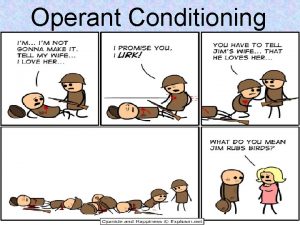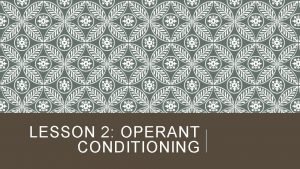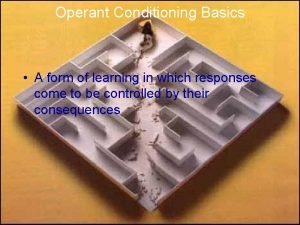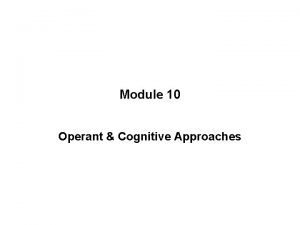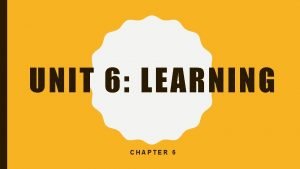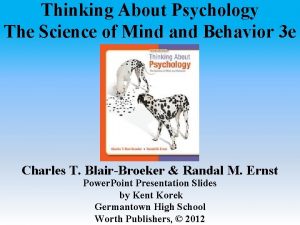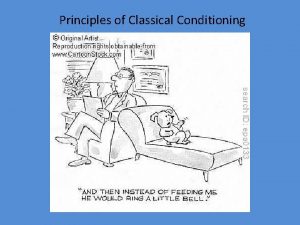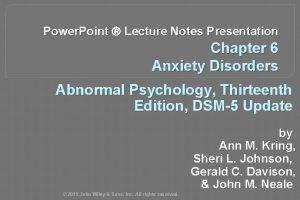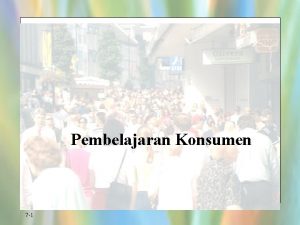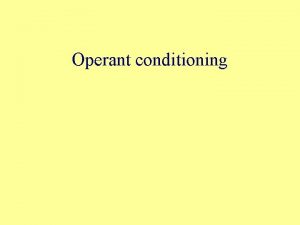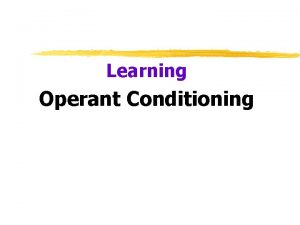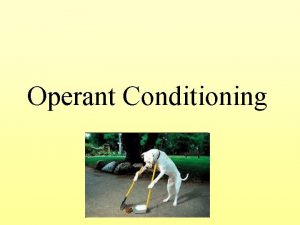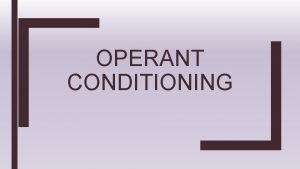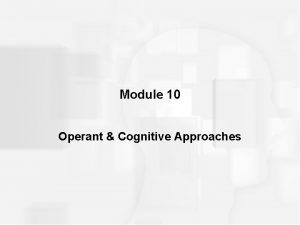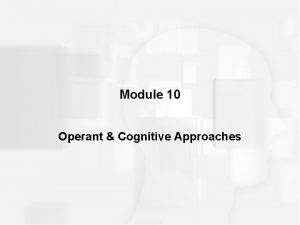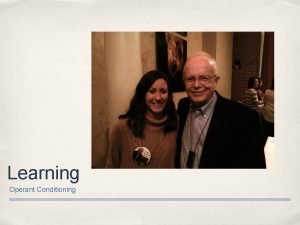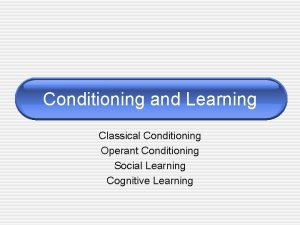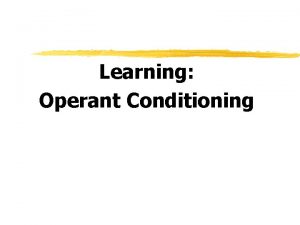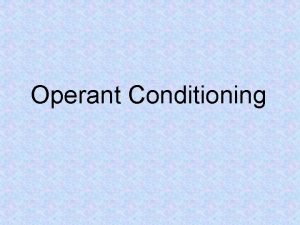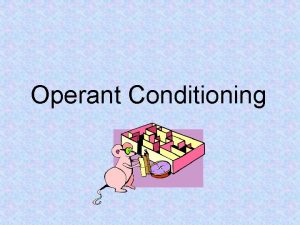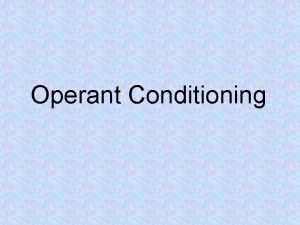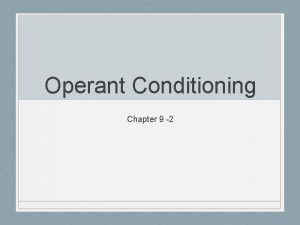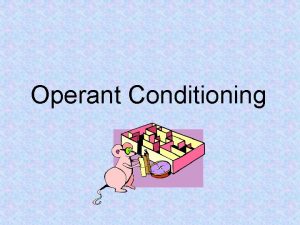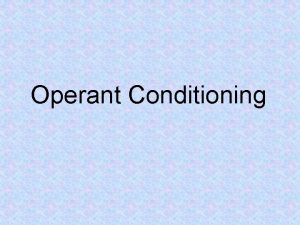Unit 5 Learning Classical Conditioning Operant Conditioning Cognitive






























































- Slides: 62

Unit 5: Learning Classical Conditioning Operant Conditioning Cognitive Learning Observational Learning

HAPPY THURSDAY! • WRITTEN PROPOSAL DUE IN 30 MINUTES – PLEASE USE LAPTOP. YOU CAN UPLOAD IT TO YOUR BLOGS! OR PRINT IT. • PRESENT IT TO THE CLASS • HOMEWORK: TRY IT! VIDEO 5 MINUTES AND PRESENT THIS ON MONDAY. • START STUDYING FOR YOUR WRITTEN RESPONSE ON WEDNESDAY(ACTUALLY A PRACTICE BUT KNOW YOUR STUFF) • Friday is the Multiple Choice portion 50 marks • I will give you a MC practice today for HW and I will review questions on Monday. After presentations I will start next unit on MEMORY!! How good is your memory?

LEARNING IS DEFINED BY: • An experience in environment, which causes a…. . • change in an organism that is • relatively permanent

Habituation • Decreased response to a stimulus judged to be of little or no importance • We engage in this type of learning so we can tune out unimportant stimuli and focus on what matters

Sensitization • Increased response to a stimulus when we are anticipating an important stimulus • We engage in this type of learning so we are prepared for dangerous situations

A Return to Behaviorism • Behaviorism states that: • learning and experience determine behavior. • Babies are tabula rasas • Psychology should focus purely on observable behaviors and not unobservable thoughts

Associative Learning • Learning that two things go together • Conditioning: A simple form of learning in which a specific pattern of behaviors is learned in the presence of welldefined stimuli • Classical conditioning aka Pavlonian conditioning • An involuntary behavior is determined by what comes before it • i. e. Baby Albert and the loud bell • i. e. Seeing the dentist’s office and feeling anxiety • Operant conditioning aka instrumental aka Skinnerian • Involves rewards and punishment • A voluntary behavior is determined by the anticipation of something that follows it • i. e. studying on a test for obtaining good grades • i. e. fastening your seat belt to avoid the obnoxious beeping

Which is which? 1. A child is attacked by a dog. The child now fears all dogs. 2. You do your homework every night to get good grades and avoid punishment. Classical – involuntary, stimulus precedes behavior Operant – voluntary, stimulus follows behavior

Classical Conditioning Definition and History • Learning in which a response naturally caused by one stimulus comes to be elicited by a different, formerly neutral stimulus • Ivan Pavlov • Accidentally discovered classical conditioning • His experiments on digestion in dogs turned into research on learning

Elements of Classical Conditioning • Unconditioned stimulus (US) • A stimulus that automatically causes a specific response in an organism • And example of a US would be food • Unconditioned response (UR) • The response caused by a US • The UR is automatic and unlearned • An example of a UR is salivation in response to food

Elements of Classical Conditioning • Conditioned stimulus (CS) • A formerly neutral stimulus (NS) that is paired with a US and eventually causes the desired response all by itself • An example of a CS is the bell in Pavlov’s studies • Conditioned response (CR) • The learned response to the CS • An example is salivation in response to the bell

Classical Conditioning • Involves a few central concepts: • Unconditioned = Unlearned • Unconditioned Stimulus • Unconditioned Response • Conditioned = learned • Conditioned Stimulus • Conditioned Response

Identifying Parts Unconditioned Stimulus (UCS) Meat powder Unconditioned Response (UCR) Salivation Conditioned Stimulus (CS) Bell Conditioned Response (CR) Salivation * Hint: replace “conditioned” with “learned” to make it more intuitive.

Little Albert: Remember!? • John Watson • Little Albert – 11 month old orphan • Showed him a white rat. No fear. • Made a loud noise. Albert cried. • Showed him a white rat and made a loud noise. Albert cried. Repeated several times. • Eventually Albert cried at white rat alone. “ Give me a dozen healthy infants, wellformed, and my own specified world to bring them up and I’ll guarantee to take any one at random and train him to become any type of specialist I might select—doctor, lawyer, merchant-chief, and yes, ever beggarman and thief, regardless of his talents, penchants, tendencies, abilities, vocations, and race of his ancestors. ” (1930)

Examples of Classical Conditioning In Humans The “Little Albert” experiment demonstrated a classically conditioned fear of white fluffy things • UCS = • Loud Noise • UCR = • Fear of Noise • NS = • Rat • CR = • Fear of Rat

Definitions • Acquisition – initial learning of the stimulus-response relationship (learning that bell means meat powder) • Extinction – diminished response to the conditioned stimulus when it is no longer coupled with UCS. (stop giving meat powder with bell and dog will stop salivating to bell) • Spontaneous recovery – reappearance of an extinguished CR after a rest. • Generalization – the tendency to respond to any stimuli similar to the CS (Dog salivates to other noises) • Discrimination – the ability to distinguish between the CS and similar stimuli (Dog only salivates to specific tone)

Application to Little Albert • If Little Albert generalized, what would we expect to happen? • He might cry at the sight of similar objects (he did – rabbit, dog, sealskin coat, some rumors – Santa’s beard) • How could we teach Little Albert to discriminate? • Continually expose him to stimuli similar to the rat, but only make the loud noise when exposing him to the rat • How could Little Albert’s conditioning be extinguished? • Continually expose him to a white rat without making the loud noise (unfortunately, this was never done because Little Albert was adopted soon after the original experiments (he would be 83 now if he is still alive – probably scared of rats!) • If Little Albert is still alive, his fear of white rats is likely to have been extinguished (no loud noise when he sees a rat). However, occasionally, when he sees a rat, he may find that his heart races for a second or two. What is this called? • Spontaneous recovery

A friend has learned to associate the sound of a dentist’s drill to a fearful reaction because of a painful experience she had getting a root canal. In this example, what is the: • • UCS? the drill UCR? CS? CR? Pain from Fear Sound of the drill Fear

Using the example in question 4, give an example of how each of the following may occur: • Extinction: if the pain does not result when the drill is used, the CS (fear) will diminish. • Spontaneous recovery: the child returns for a visit the next day and the sound of the drill elicits fear again. • Generalization: the child becomes fearful of the sound of any motor • Discrimination: the child learns that only the high pitched dentist drill is associated with pain and not a low pitch hum of the vacuum cleaner.

A BMW commercial has lots of pretty people in it. People who watch the commercial find the people pleasing to look at. With repeated viewing, they begin to associate the car with the pleasant feeling. • • UCS? UCR? CS? CR? Pretty people Feeling good Sight of BMW Feeling good

You get in a car accident and find you are afraid to get in a car. • UCS? • UCR? • CS? car • CR? Pain of the accident Fear Presence of Fear

You go to a fancy restaurant and decide to try an appetizer you’ve never tried before – escargot. After dinner, you go to a concert and get violently ill (from a stomach virus that’s been going around). From then on, you can’t even look at snails without feeling sick. • UCS? • UCR? • CS? snails • CR? Stomach virus Feeling sick Sight of Feeling sick

You are cruising on 440 at 75 mph when you see flashing police lights behind you. You pull over and the policeman gives you a ticket. You get in insane amounts of trouble from your parents. The next time you see flashing police lights, your heart rate speeds up. • UCS? Getting in trouble from parents • UCR? Increased heart rate • CS? Flashing lights • CR? Increased heart rate

Classical Conditioning in Humans: Class Demonstration • Lick your finger and dip it into your cup of lemonade powder, but DO NOT EAT IT. • When you hear the tone, immediately eat the powder on your finger, and then dip your finger back into the cup to prepare for the next trial. • You must eat some of the powder immediately after each tone, but not any other time. • After several “learning” trials, you will be instructed to simply listen to the tone without eating the powder. • What happens? Label the UCS, UCR, NS, CS and CR in your notes based on the demo.

New Learning Based on Old: Higher Order Conditioning • Once a neutral stimulus becomes a conditioned stimulus, it may function as an unconditioned stimulus to elicit new learning. • For instance, in Pavlov’s experiment, once the bell produced the salivation response in the dogs, it could be paired with a new neutral stimulus, such as a red light, until the dogs learned to salivate to the red light.

Classical Conditioning: Key Variables • In order for Classical Conditioning to work the following variables must exist: • STRENGTH - Stimuli (UCS, NS) must be noticeable enough to provoke a response. • TIMING - UCS and NS must be paired close together so that an association is made between the two. • FREQUENCY - UCS and NS must be paired together many times so that an association is made between the two and the NS can come to elicit the same response as the UCS.

Classical Conditioning: Extinction and Spontaneous Recovery • Extinction – • After a period of time passes when CS is not paired with UCS, CS returns to being an NS • e. g. Baby Albert would eventually cease to be afraid of white fluffy things after they were not paired with a horrible and frightening noise. • Spontaneous Recovery – • Just because extinction occurs, does it mean that the learning is gone completely? No! • After extinction, it is not unusual to see the recurrence of the conditioned response • This proves the learning never disappeared; it was just obscured by new learning - like interference

Classical Conditioning: Generalization and Discrimination • Generalization – • An organism may learn to respond not only to the CS, but also to other stimuli that are similar to the CS. • e. g. Baby Albert was conditioned to fear a white rat, but also feared cotton balls, rabbits, white sweaters, etc. • Discrimination – • Organisms can also learn to decipher between similar stimuli when only particular stimuli are paired with a UCS.

Classical Conditioning in the Real World Taste Aversion and the Garcia Effect • Some learning mechanisms are so powerful they do not require frequency of pairings. • Taste Aversion – • Occurs when organism becomes ill following consumption of a particular food. • Organism may never be able to eat the food again. • WHY? • Garcia Effect – • Using principles of taste aversion, John Garcia put this phenomenon to good use • Sprinkled carcass of sheep with a chemical that caused illness in coyotes • Coyotes did not attack the livestock following this experience

Biological Predispositions It was once believed that conditioning occurred the same in all animals (and therefore you could study human behavior by studying any animal) and that you could associate any neutral stimulus with a response. Not so. Animals have biological predispositions to associating certain stimuli over others • Example – You eat a novel food and later get sick. You will be conditioned to associate the taste of the FOOD with getting sick (and thus avoid that food in the future), but NOT the music playing in the restaurant, the plate it was served on, or the perfume your neighbor was wearing. • It is much easier to condition someone to have a fear of snake than of flowers. • Birds hunt by sight and will more quickly become conditioned to the SIGHT of tainted food

Classical Conditioning in the Real World: Preparedness and Contrapreparedness • Some conditioned responses come naturally, others do not. • Preparedness • Conditioned behaviors that work well with organism’s instinctive behaviors and are easy to train • e. g. phobia of snakes or spiders • Contrapreparedness • Other conditioned behaviors go against the organism’s instinctive behaviors and are difficult or impossible to train. • e. g. phobia of chairs or tables?

Classical Conditioning in the Real World: Treating Phobias • Many phobias are learned responses and can be unlearned • This can be done gradually or all at once • Systematic Desensitization • Therapist and client generate “fear hierarchy” of situations that are increasingly threatening • Client then learns relaxation techniques • Client experiences “en vivo” therapy to directly experience each item on fear hierarchy to gradually unlearn his/her fear • Flooding • Client faces worst-case-scenario involving fear • If they can survive this, they have no reason so be fearful every day

Name one practical application of classical conditioning. • Stop drug or alcohol addiction by pairing a nausea-producing drug with the drug of addiction. • Extinguish a drug addiction by administering a drug that blocks the pleasant feeling normally elicited by the drug. • If a child is afraid of rabbits because one bit him when he was young, you can expose the child to rabbits in safe environments repeatedly until the behavior is extinguished

Cognitive Processes • It was once thought that cognitive processes weren’t involved in classical conditioning. Now we know better. For example, therapists give alcoholics drink containing a nausea-producing drug to condition them to avoid alcohol. Because clients KNOW that the drug is what is actually causing the nausea, it doesn’t work so well.

Operant Conditioning

Operant Conditioning • Learning in which an organism engages in a spontaneous behavior which is followed by a consequence a reward or punishment • Organism learns to perform behavior in order to gain a reward or avoid a punishment

Law of Effect • If a behavior is reinforced, it is MORE likely to occur • If a behavior is punished, it is LESS likely to occur

History of Operant Conditioning • E. L. Thorndike • Researched cats in a puzzle box • Cats learned to escape from box to attain a reinforcement of food • B. F. Skinner • Created a device called a Skinner Box to train organisms using operant conditioning • Also did research on superstition (pigeons) and connected it to the principles of operant conditioning

Elements of Operant Conditioning • Reinforcer • A stimulus or event that follows a behavior and makes that behavior more likely to occur again • Punisher • A stimulus or event that follows a behavior and makes that behavior less likely to occur again

Types of Reinforcement • Positive reinforcer (+) • Adds something rewarding following a behavior, making that behavior more likely to occur again • Giving a dog a treat for fetching a ball is an example • Negative reinforcer (-) • Removes something unpleasant from the environment following a behavior, making that behavior more likely to occur again • Taking an aspirin to relieve a headache is an example

Types of Reinforcement • Primary reinforcer • Adds something intrinsically valuable to the organism • Giving a dog a food for shaking hands • Secondary reinforcer • Adds something with assigned value to the organism • Giving a person $100 for each A on their report card

Types of Punishment • Positive Punishment (+) • Adds something undesirable to decrease a behavior • Spanking a child for swearing • Negative Punishment (-) • Removes something desirable to decrease a behavior • Taking a child’s toy away for swearing • Also called omission training

Types of Punishment • Primary Punishment • Method of decreasing behavior is directly threatening to organism’s survival • Beating a prisoner for trying to escape • Secondary Punishment • Method of decreasing behavior is undesirable, but not life-threatening • Taking away a prisoner’s recreational privileges for trying to escape

Complex Behaviors and Shaping • Some behaviors are too complex to occur spontaneously • For these behaviors, shaping must be used • Shaping reinforces successive approximations to the desired behavior • Organism eventually learns what the desired behavior is in small steps • Similar to playing “hot and cold” • Our class demonstration?

Preparedness and Contrapreparedness in Operant Conditioning • Some changes in behavior are easily trained • Preparedness • Conditioned behaviors that work well with organism’s instinctive behaviors and are easy to train • e. g. Brelands’ “Dancing Chicken” • Contrapreparedness • Other conditioned behaviors go against the organism’s instinctive behaviors and are difficult or impossible to train. • e. g. Brelands’ raccoon

Reinforcement vs. Punishment? • Punishment not as effective as reinforcement • Does not teach proper behavior, only suppresses undesirable behavior • Causes upset feelings that can impede learning • May give impression that inflicting pain is acceptable

Effective Punishment? • Effective punishment must be • SWIFT • Should occur as soon as possible after the behavior • CERTAIN • Should occur every time the behavior does • SUFFICIENT • Should be strong enough to be a deterrent • CONSISTENT • Should apply to all individuals the same way

Impact of Punishment • When punishment is given haphazardly, learned helplessness can result. • Learned Helplessness occurs when NO MATTER WHAT THE ORGANISM DOES, it cannot change the consequences of behavior. • Martin Seligman’s experiment with dogs showed that dogs given a series of inescapable shocks stopped trying to escape the shocks even when given the opportunity to escape later. • Another example would be finding that whether or not you study for your calculus tests, you fail, so you stop trying altogether.

Alternatives to Punishment • An alternative to punishment if known as AVOIDANCE TRAINING • the organism is given a “warning” before punishment occurs so it may change its behavior in order to avoid an unpleasant consequence like a punishment. • ex/”Counting to three” before punishment is delivered to provoke a child to stop misbehaving.

Big Bang Theory Examples • https: //www. youtube. com/watch? v=Lh. I 5 h 5 JZi-U • https: //www. youtube. com/watch? v=Mt 4 N 9 GSBo. MI (positive re) • https: //www. youtube. com/watch? v=imkbu. Kom. PXI

Behavioral Change Using Biofeedback • Biofeedback is an operant technique that teaches people to gain voluntary control over bodily processes like heart rate and blood pressure • When used to control brain activity it is called neurofeedback

Schedules of Reinforcement • Interval schedules • Reinforcement depends on the passing of time • Fixed-interval schedule • Reinforcement follows the first behavior after a fixed amount of time has passed • An example would be receiving a paycheck every two weeks • Variable-interval schedule • Reinforcement follows the first behavior after a variable amount of time has passed • An example would be pop quizzes

Schedules of Reinforcement • Ratio schedules • Reinforcement depends on the number of responses made • Fixed-ratio schedule • Reinforcement follows a fixed number of behaviors • For example, being paid on a piecework basis • Variable-ratio schedule • Reinforcement follows a variable number of behaviors • An example would be playing slot machines

Response Patterns to Schedules of Reinforcement • Which schedule yields the fastest response rate? • What happened in our class demonstration?

Cognitive Learning (Tuesday)

Cognitive Learning • Sometimes learning involves more than simply reacting to stimuli – it involves THINKING! • Cognitive Learning • Learning that depends on mental activity that is not directly observable • Involves such processes as attention, expectation, thinking, and memory • While behaviorists typically focus on learning that is based on reactions, cognitive psychologists explain learning in terms of additional mental processes.

Generative Learning and Insight • Generative learning • Using what you know to figure out something you don’t • E. g. realizing a new song is by a favorite group of yours • Insight • After thinking about a problem for a bit, you suddenly figure it out • E. g. Kohler’s chimps

Latent Learning and Cognitive Maps • Latent learning • learning that takes place before the subject realizes it and is not immediately reflected in behavior • Taking a test on material learned over the course of a few weeks • Cognitive mapping • latent learning stored as a mental image • Slideshow experiment

Insight and Learning Sets • Learning sets/Learning to Learn • refers to increasing effectiveness at problem solving through experience • organisms “learn how to learn” • Figuring out how to study best • Trial and Error Learning • Learn by your mistakes • Class demonstration - “Blind Maze” - what happened?

Learning by Observing • Social learning theory or Observational Learning theory focuses on what we learn from observing other people • Albert Bandura’s Bobo Doll experiment • Children imitated adult role model - adult models behavior and child imitates • Vicarious reinforcement or vicarious punishment affects the willingness of people to perform behaviors they learned by watching others

Cognitive Learning in Nonhumans • Nonhumans are capable of classical and operant conditioning • Nonhumans are also capable of latent learning • Research has also demonstrated that animals are capable of observational learning

Do Now: • 1. Stand stayed out past his curfew. His parents demanded that he surrender his car keys for two weeks. Stand has not broken curfew since. • 2. Jane decided to draw a picture on her bedroom wall with crayons. Her mom beat her with a wooden spoon. She no longer draws on the walls. • 3. Alex got all As on his report card, so his mother relieves him of having to go Christmas shopping with her. • 4. When the kindergarteners in Ms. Trager’s class behave well, she takes them outside to play on the playground. • 5. Rachel found out that her boyfriend Bert lied to all their friends about how they met, claiming that she wanted him first. Now Rachel refuses to hold Bert’s hand. Bert doesn’t lie about their relationship anymore.
 Difference between operant and classical conditioning
Difference between operant and classical conditioning Operant vs classical conditioning
Operant vs classical conditioning Variable interval reinforcement
Variable interval reinforcement Operant conditioning
Operant conditioning Classical conditioning vs operant conditioning
Classical conditioning vs operant conditioning Instrumental learning vs classical conditioning
Instrumental learning vs classical conditioning Classical vs operant conditioning
Classical vs operant conditioning Operant and classical conditioning
Operant and classical conditioning Classical conditioning vs operant conditioning
Classical conditioning vs operant conditioning Operant conditioning classical conditioning
Operant conditioning classical conditioning Social learning theory vs operant conditioning
Social learning theory vs operant conditioning Latent learning ap psychology
Latent learning ap psychology Compare and contrast operant and classical conditioning
Compare and contrast operant and classical conditioning Is social learning theory deterministic
Is social learning theory deterministic Social learning theory vs operant conditioning
Social learning theory vs operant conditioning Classical conditioning
Classical conditioning Instrumental learning vs classical conditioning
Instrumental learning vs classical conditioning Home youtube
Home youtube Edward thorndike puzzle box
Edward thorndike puzzle box Dinesh ramoo
Dinesh ramoo Operant conditioning def
Operant conditioning def Skinner box
Skinner box Continuous schedule of reinforcement example
Continuous schedule of reinforcement example Operant conditioning
Operant conditioning Latent learning
Latent learning Example of fixed ratio schedule
Example of fixed ratio schedule Operant conditioning definition
Operant conditioning definition Operant conditioning definition
Operant conditioning definition Secondary reinforcer
Secondary reinforcer Operant conditioning and personality
Operant conditioning and personality Operant conditioning terminology
Operant conditioning terminology Principles of operant conditioning
Principles of operant conditioning Module 27 operant conditioning
Module 27 operant conditioning Respondent vs operant conditioning
Respondent vs operant conditioning Thorndike operant conditioning
Thorndike operant conditioning Applications of operant conditioning
Applications of operant conditioning Thinning operant conditioning
Thinning operant conditioning Youtube operant conditioning
Youtube operant conditioning Introduction of learning
Introduction of learning Operant conditioning images
Operant conditioning images Operant conditioning parenting
Operant conditioning parenting Operant conditioning
Operant conditioning Operant conditioning theory
Operant conditioning theory Applications of operant conditioning
Applications of operant conditioning Behaviorism ap psychology definition
Behaviorism ap psychology definition Operant conditioning
Operant conditioning Contrapreparedness
Contrapreparedness Skinner theory
Skinner theory Operant respondent
Operant respondent Operant conditioning
Operant conditioning Operant conditioning
Operant conditioning Operant conditioning
Operant conditioning Positive punishment def
Positive punishment def Operant conditioning images
Operant conditioning images Lesson 2 operant conditioning
Lesson 2 operant conditioning Operant conditioning
Operant conditioning Operant conditioning
Operant conditioning Cognitive and non cognitive religious language
Cognitive and non cognitive religious language Classical conditioning examples
Classical conditioning examples Ivan pavlov theory
Ivan pavlov theory Order of classical conditioning
Order of classical conditioning Classical conditioning panic disorder
Classical conditioning panic disorder Contoh iklan classical conditioning
Contoh iklan classical conditioning







